Do you really need a technique for breathing? Isn’t it supposed to be an automatic process? These are the questions a person would typically ask when they first come across the phrase “breathing techniques for running”. If you are a runner or just starting, you should know all about breathing techniques during running to improve your speed and efficiency. Regardless of age, experience, and fitness level, every runner can reap the rewards by practicing proper running techniques. This is because your bodily functions work the same way during runs. When you run, your cells and muscles rely on the continuous delivery of oxygen and carbon dioxide to stay in motion. Proper breathing allows an adequate muscle function of the diaphragm. This plays a pivotal role in stabilizing the pelvis and gives you a better running form. Breathing well during runs may also regulate your nervous system, allowing you to run calmly and stay in control when the distance increases or you can’t keep up the pace (1). Everyone who plans to hit the tracks this season should learn proper breathing techniques for running. Implementing them during runs will help you stay comfortable and enjoy the endeavors.
What Are The 3 Breathing Techniques For Runners?
Establishing an efficient breathing cadence while running may enhance endurance and reduce injury risks. It also allows the runners to gradually push past a plateau in their training.
Here are the three different types of breathing techniques that have proven effective for runners:
Nasal Breathing
This technique involves breathing exclusively in and out through the nose. It compels the body to stand tall and activates the diaphragm as the runner breathes into the belly (2). Try this technique for about 3 to 5 minutes and run as slowly as required.
Breathing through the nose is suited for easy runs and moderate jogging rather than sprints. In this type of breathing, the runner must exhale through the nostrils without involving their mouth.
Mastering this breathing technique may take some time, but it will bring some positive returns in the future. You can try and practice this type of breathing while you are walking or working around the house on random chores.
Nose And Mouth Breathing
The second technique involves inhaling through the nose and exhaling through the mouth, as you can’t exclusively breathe through the nose all the time. Even though some people have no problem mastering nasal breathing, this technique is also quite famous for its ease.
Practicing a convenient breathing technique is essential for making your runs comfortable. Perhaps this is why many runners settle for a combination of nose and mouth breathing.
This is one of the best breathing techniques for running long-distance and runs where you must increase your pace with a moderate effort. A mere 10 to 20 breaths inhaled through the nose and exhaled through the mouth could provide a much-needed reset to your breathing mechanism.
Read More: Rowing Vs. Running: What Should You Choose To Reach Your Fitness Goals?
Mouth Breathing
Mouth breathing, as the name suggests, involves inhaling and exhaling through the mouth. It is a default technique for most runners, but going overboard with it could develop bad habits, such as inhaling more through the chest and shoulders than the diaphragm.
Some problems that may occur with excessive mouth breathing include an elevated heart rate, poor pelvic stability, and erratic breathing.
Ensure that you practice a proper mouth-breathing method to stay steady and steer clear of all the risks. This involves breathing deeply into the belly and diaphragm.
Mouth breathing is an ideal technique for high-intensity running because it allows the runners to breathe as much air as possible. People often switch to mouth breathing when going uphill or performing sprints.
Lastly, you must ensure that you are inhaling fresh air during runs. If you plan to run outdoors in an urban location, choose the time of the day when there is less traffic. A better option would be to run in a nearby park or track where there is little pollution.
Which Breathing Technique Is Best For Running?
Following proper breathing techniques for running can hugely impact your performance. It is natural for the heart rate to escalate during exercise. The heart pumps as a response to breathing. When you inhale, the heart slows down, and the body registers a higher level of carbon dioxide. In reaction to this process, the nervous system asks for an uptick in breath rate to clear the carbon dioxide, hence an exhaled breath occurs as a result (3).
Studies reveal that good breathing techniques for running may have little impact on the overall running economy, but it increases positive emotions in the runners. This, in turn, leads them to run stronger and longer.
The techniques discussed earlier show multiple ways to keep your breathing steady as you run. The runners need to curate a plan of running breathing techniques, and practice the one that favors them the most.
Another powerful tool to get more oxygen and reduce the impact of running on your body is rhythmic breathing. It involves creating a rhythm between breathing and how you run, also called the gait.
Rhythmic breathing is a mindful running skill known in clinical terms as locomotor-respiratory coupling (LRC). LRC helps build energy and works as a mediator of breath rate and running pace (4).
There are several types of running and breathing rhythms. Note that the best kind of rhythm feels sustainable and easy to practice.
Here are some techniques you can try:
- If you are on a low-intensity run, try breathing three steps in and three steps out (a 3:3 ratio). You can also extend it to 6:6, but many runners find 4:4 to be best suited.
- You should follow a 2:2 breathing during sprints or interval training.
- Know that 1:1 breathing is a danger zone. Just use it for 20 seconds to get through the sprints.
These rates should be considered as rules of thumb. Each runner has to choose according to their stamina. It would be best to try multiple breathing rhythms and opt for the most comfortable one.
To prevent muscular imbalances, alternate the exhales between the right and left foot. Rhythmic breathing exerts lower pressure on the diaphragm and balances the stress of the impact between both sides of your body.
This breathing technique for running makes you focus on fitting your breath to an optimal foot strike pattern. Then, the awareness of breathing allows you to create a link between mind and body– helping you create a smooth pathway to gauge your running efforts.
When you feel the run, it allows you immediate and precise control over your entire body. You can remain calm and avoid any stress that could inhibit your performance.
Lean and toned up body isn’t just a far-fetched fantasy. Check out the BetterMe app and watch it propel your weight loss journey into high gear!
How Can I Strengthen My Lungs For Running?
Both lungs and heart benefit from running and exercising. The lungs provide oxygen, while the heart supplies blood to the muscles.
Experts recommend 30 minutes of moderate exercise five times per week to improve lung capacity (5). Moderate exercise typically includes brisk walking, running, jogging, or other cardiovascular activities. Regular workouts increase the air your lungs can intake by 5 to 15 percent (6). This then leads to improved endurance and reduced breathlessness.
Keeping your lungs healthy can be an effective way to avoid problems during running. So, here are some tips to keep your lungs healthy:
- Consume food rich in fiber and antioxidants
- Improve the air quality indoors with tools like air filters or artificial fragrances
- Get vaccines, such as pneumonia and flu vaccines. These will prevent lung infections and promote lung health.
- If you are a smoker, consider quitting this habit. Also, avoid secondhand smoke or environmental pollutants.
Some of the best measures you can take to improve your lungs and strengthen them don’t have anything to do with your training routine. Your lifestyle choices, including your diet and environment, is what can positively impact your lungs.
Read More: Hill Running Workout: Head Towards The Rocks To Ace The Race
Why Do I Struggle To Breathe When Running?
Strenuous activities like running can cause your muscular and respiratory systems to work harder than their ordinary functioning. Your body needs more oxygen, and it must remove carbon dioxide buildup. This makes it difficult to breathe.
The shortness of breath indicates the fitness level and allows runners to determine how their bodies respond to the pace and intensity of running. So, if you struggle to breathe when running, you should understand that you have worked past your capacity.
Creating a pattern of the best breathing techniques during running and practicing them will help you to expand your capacity and make the runs easier on your body.
The Bottom Line
Talk to your doctor before you design a running routine for yourself. Those new to a fitness training program may find it hard to practice the best breathing techniques for running. Even experienced runners should get regular medical check-ups to maintain their capacity and make the most of their running routines.
Also, if you wish to see continual progress and build your body strength, you must incorporate rest, a healthy diet, and proper warm-ups in your training program. Remember that it’s okay to also take it easy, and so don’t feel guilty resting when your body asks for it.
DISCLAIMER:
This article is intended for general informational purposes only and does not serve to address individual circumstances. It is not a substitute for professional advice or help and should not be relied on for making any kind of decision-making. Any action taken as a direct or indirect result of the information in this article is entirely at your own risk and is your sole responsibility.
BetterMe, its content staff, and its medical advisors accept no responsibility for inaccuracies, errors, misstatements, inconsistencies, or omissions and specifically disclaim any liability, loss or risk, personal, professional or otherwise, which may be incurred as a consequence, directly or indirectly, of the use and/or application of any content.
You should always seek the advice of your physician or other qualified health provider with any questions you may have regarding a medical condition or your specific situation. Never disregard professional medical advice or delay seeking it because of BetterMe content. If you suspect or think you may have a medical emergency, call your doctor.
SOURCES:
- Research: Why Breathing Is So Effective at Reducing Stress (2020, hbr.org)
- What Are the Advantages of Nose Breathing Vs. Mouth Breathing? (2021, healthline.com)
- Vision and Breathing May Be the Secrets to Surviving 2020 (2020, scientificamerican.com)
- Breath Tools: A Synthesis of Evidence-Based Breathing Strategies to Enhance Human Running (2022, frontiersin.org)
- Exercise and Lung Health (2022, lung.org)
- Your lungs and exercise (2016, ncbi.nlm.nih.gov)










